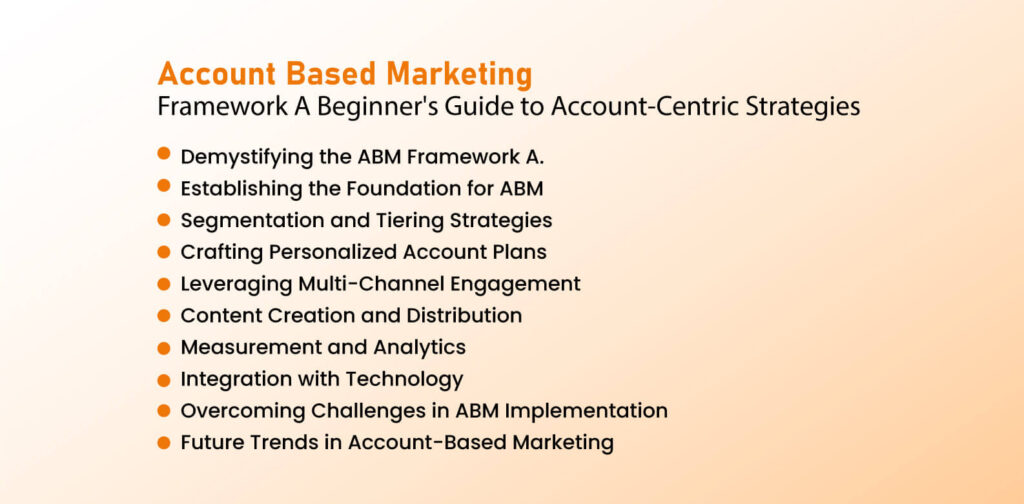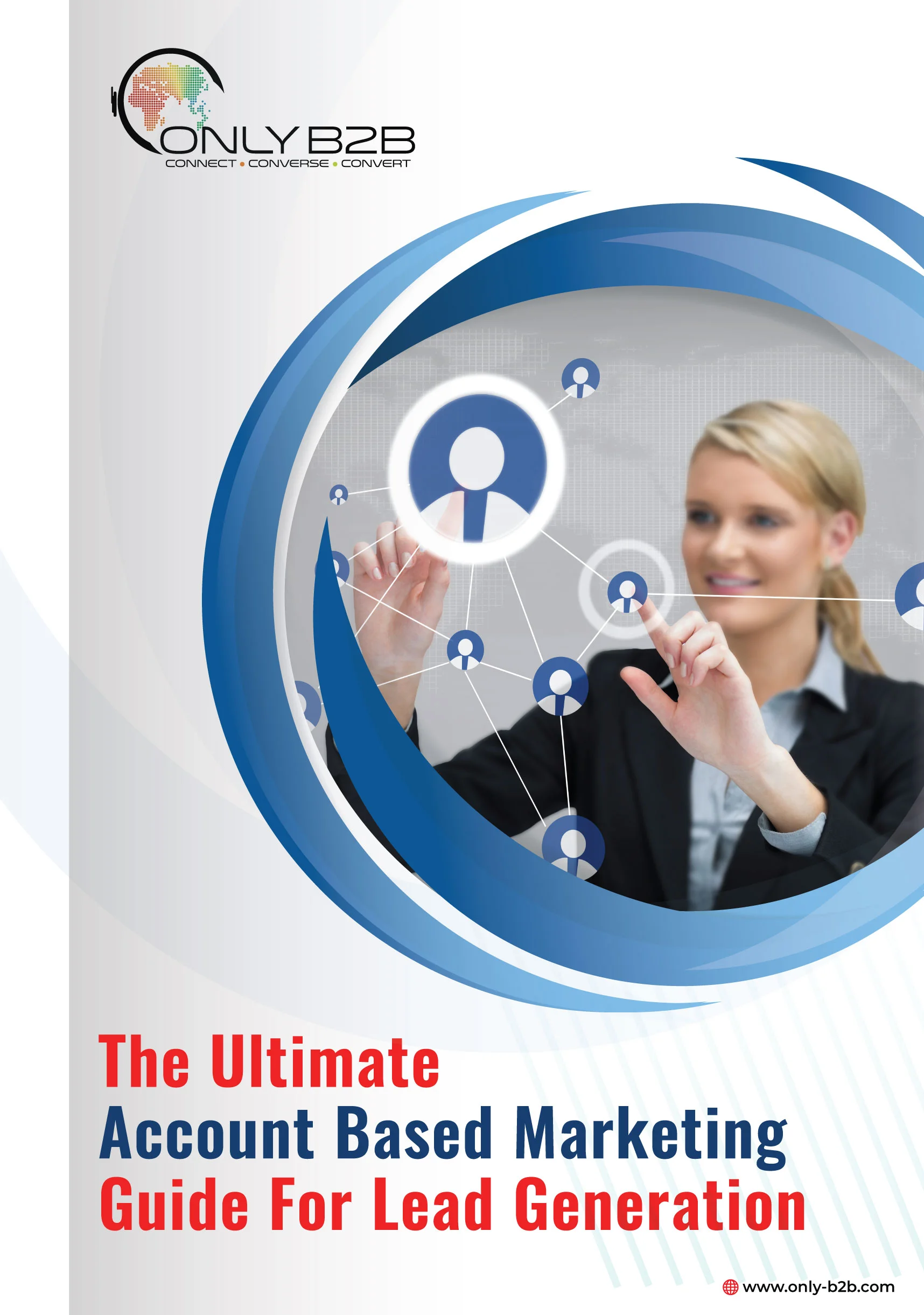
In the ever-evolving landscape of B2B marketing, one strategy has emerged as a powerful weapon in the arsenal of marketers: Account-Based Marketing (ABM). This approach shifts the focus from casting a wide net to targeting specific high-value accounts with personalized and tailored strategies. In this comprehensive blog, we will delve into the intricate world of Account-Based Marketing Framework, demystify its core components, highlight its benefits, and provide actionable insights for successful implementation.
Imagine a world where marketing isn’t about broadcasting your tymessage to the masses, but rather crafting an exclusive experience for select accounts. That’s the essence of Account-Based Marketing. It’s like creating a bespoke suit instead of picking one off the rack, tailoring your approach to the unique characteristics of each account.
While ABM offers immense potential, avoiding common account-based marketing mistakes is crucial for maximizing its effectiveness.
In a world saturated with marketing noise, businesses are seeking more effective ways to stand out and make meaningful connections. ABM provides that edge by homing in on the accounts that matter most. However, to execute ABM successfully, a structured framework is crucial. This guide will walk you through the steps of building an effective ABM framework.
The heart of ABM lies in its account-centric strategies. These strategies revolve around understanding the unique needs, pain points, and objectives of each target account. By crafting personalized plans and content, businesses can create a stronger resonance with their prospects, leading to higher conversion rates and more valuable customer relationships
Must Read: How to Leverage Account-Based Marketing (ABM) for Marketing Qualified Leads
Account Based Marketing Framework: A Beginner’s Guide to Account-Centric Strategies.

Demystifying the ABM Framework:
An effective ABM framework consists of several core components, including target account identification, collaboration between sales and marketing, personalized messaging, multi-channel engagement, content creation, analytics, and technology integration.
Understanding how these components work together is essential for a successful ABM strategy.
A. Why ABM is Different from Traditional Marketing
Unlike traditional marketing, which focuses on generating B2B leads and nurturing them through a generic funnel, ABM starts with identifying high-potential accounts and tailoring marketing efforts directly to them.
This difference leads to a higher ROI, stronger customer relationships, and a more efficient use of resources.
B. Benefits of Implementing an Account-Based Approach
The benefits of ABM are well-documented. According to a study by the Alterra Group, 97% of marketers reported higher ROI with ABM than with any other marketing approach.
Moreover, SiriusDecisions found that organizations with tightly aligned sales and marketing teams achieved 24% faster three-year revenue growth and 27% faster three-year profit growth.
Must Read: Measuring the ROI of Your Account based marketing Strategy : Key Metrics to Track for Success
Establishing the Foundation for Account Based Marketing Framework
A. Identifying and Prioritizing Target Accounts
The first step in implementing ABM is identifying the right accounts to target. Utilize data-driven insights, historical data, and predictive analytics to pinpoint accounts with the highest potential for conversion. P
rioritize these accounts based on their fitting with your ideal customer profile and their potential revenue impact.
B. Aligning Sales and Marketing Teams for Collaboration
A key challenge in many organizations is the misalignment between sales and marketing teams. ABM requires close collaboration between these teams to ensure that marketing efforts align with sales goals and objectives.
Regular communication, shared goals, and a unified approach are essential.
C. Crafting a Unified Message for Account Personalization
One-size-fits-all messaging is ineffective in ABM. Instead, craft a unified message that resonates with the specific pain points and objectives of each target account.
This requires a deep understanding of the account industry, challenges, and goals.
Must Read: The Role of AI in ABM: Enhancing Personalization and Efficiency
Segmentation and Tiering Strategies
A. Creating Segmentation Criteria for Target Accounts
Segmentation is a crucial aspect of ABM. Divide your target accounts into segments based on industry, company size, location, and other relevant factors.
This segmentation will guide your personalized approach and content creation.
B. Tiering Accounts Based on Strategic Importance
Not all accounts are created equal. Tier your accounts based on their strategic importance and potential revenue impact. This tiering allows you to allocate resources effectively and tailor your approach to each tier.
C. Tailoring Content and Engagement for Each Tier
Each tier requires a different level of engagement and content. High-priority accounts might receive personalized video messages from the CEO, while lower-priority accounts might receive targeted email campaigns.
This tiered approach ensures that resources are allocated wisely.
Must Read: Skyrocket Your ROI: Discover the Most Effective Types of Account-Based Marketing
Crafting Personalized Account Plans
A. Developing Detailed Account Profiles and Insights
Thoroughly research each target account to create detailed profiles that include company information, pain points, decision-makers, and more. Leverage both internal and external data sources to gain a comprehensive understanding.
B. Setting Clear Goals and Objectives for Each Account
Define clear and measurable goals for each target account. Whether it’s a product demo, a consultation call, or a face-to-face meeting, having well-defined objectives ensures that your efforts are focused, and results driven.
C. Creating Customized Strategies for Account Engagement
Craft personalized strategies for engaging with each target account. This might involve a combination of email outreach, social media engagement, personalized content, and direct communication with key stakeholders.
Leveraging Multi-Channel Engagement
A. Utilizing Digital Channels for Personalized Outreach
Digital channels such as email, social media, and online advertising play a crucial role in ABM. Use these channels to deliver personalized messages and content to key decision-makers within the target accounts.
B. Integrating social media in Account Engagement
Social media platforms such as Facebook, Instagram, LinkedIn, and Twitter provide an opportunity to connect with key stakeholders in a more informal and engaging way.
Share relevant content, participate in discussions, and establish a thought leadership presence to build credibility.
C. Orchestrating Cross-Channel Account Touchpoints
Consistency is key across all touchpoints. Coordinate your messaging and content across various channels to ensure that the target account receives a cohesive and personalized experience at every interaction.
Must Read: The Importance of Account-Based Marketing: Past, Present, and Future
Content Creation and Distribution
Developing Content Aligned with Account Needs
Content is the cornerstone of any marketing strategy, and ABM is no exception. Develop content that addresses the specific pain points, challenges, and goals of each target account. This might include case studies, industry insights, and solution-oriented content.
Distributing Tailored Content to Key Stakeholders
Identify the key stakeholders within each target account and tailor your content distribution to their preferences. A CFO might be interested in ROI-focused content, while a CMO might be more interested in marketing trends and strategies.
Showcasing Thought Leadership for Account Value
Position your brand as a thought leader in the industry by sharing valuable insights, research, and innovative ideas. This not only builds credibility but also demonstrates your commitment to providing value to your target accounts.
Must Read: The Most Effective Methods For Creating ABM Target Account Lists
Measurement and Analytics
A. Identifying Key Metrics for ABM Success
Measuring the success of your ABM strategy requires defining relevant metrics. These might include engagement rates, conversion rates, pipeline velocity, deal size, and customer retention.
B. Tracking Engagement and Interaction Metrics
Utilize analytics tools to track how target accounts are engaging with your content and messages. Monitor open rates, click-through rates, website visits, and social media interactions to gauge their level of interest.
C. Continuous Improvement through Data-Driven Insights
ABM is an iterative process. Analyze the data you gather to identify trends, strengths, and areas for improvement. Adjust your strategies and tactics based on these insights to continuously enhance your approach.
Must Read: The Most Effective Methods For Creating ABM Target Account Lists
Integration with Technology
A. Utilizing CRM and Marketing Automation Platforms
CRM and marketing automation platforms play a critical role in ABM. These tools help you manage contacts, track interactions, and automate certain aspects of your engagement strategy.
B. Implementing ABM-Specific Tools for Personalization
Several ABM-specific tools are available to enhance personalization and engagement. These tools use predictive analytics to provide insights into account behavior, helping you tailor your approach further.
C. Integrating ABM Data for Holistic Insights
Integrate your ABM data with other systems to gain a holistic view of account behavior and interactions. This integration enables you to make more informed decisions and refine your strategies.
Must Read: A Brief Guide to Generate Leads Using ABM Content Syndication
Overcoming Challenges in ABM Implementation
A. Balancing Scale and Personalization
Scaling ABM can be challenging, as personalization is a time-intensive process. Automation and AI-driven insights can help strike a balance between scale and personalization.
B. Managing Data Accuracy and Quality
ABM relies on accurate and high-quality data. Regularly clean and update your data to ensure that your outreach efforts are targeted and relevant.
C. Adapting to Evolving Account Needs
Account needs and priorities can change over time. Stay agile and be prepared to adapt your strategies to align with these evolving needs.
Must Read: Implement Automation Tools To Soar Your ABM Efforts
Future Trends in Account-Based Marketing
AI and Predictive Analytics for Enhanced Account Insights
Artificial intelligence and predictive analytics will play a larger role in ABM, providing deeper insights into account behavior and enabling more accurate predictions about account engagement and conversion.
B. Integration of ABM with Customer Experience (CX) Strategies
The line between marketing and customer experience is blurring. Integrating ABM with CX strategies will create a seamless and consistent experience from the first touchpoint to post-purchase interactions.
C. Personalization at Scale through Advanced Technology
Advancements in technology will enable personalization to an even greater scale. Machine learning algorithms and data-driven insights will empower marketers to deliver highly personalized experiences to a broader audience.
Must Read: Build A Strong ABM Campaign With Account Mapping Techniques
Know everything about Abm framework in the videot below.
Conclusion
Account-Based Marketing Framework is not just a strategy; it’s a mindset shift that places the customer at the center of your efforts. By understanding the basics of ABM, creating a structured framework, and implementing personalized strategies, businesses can tap into the immense potential of account-centric marketing.
As technology continues to evolve and customer expectations rise, embracing ABM will be the key to standing out in a competitive B2B landscape.
In this beginner’s guide to Account-Centric Strategies, we’ve explored the nuances of ABM, dissected its core components, and highlighted the benefits of this approach.
Armed with actionable insights and a comprehensive framework, you’re now equipped to embark on your journey toward mastering Account-Based Marketing.
As the B2B landscape continues to evolve, remember that ABM isn’t just a strategy; it’s a philosophy that empowers you to build lasting relationships and drive meaningful growth.

Vikas Bhatt is the Co-Founder of ONLY B2B, a premium B2B lead generation company that specializes in helping businesses achieve their growth objectives through targeted marketing & sales campaigns. With 10+ years of experience in the industry, Vikas has a deep understanding of the challenges faced by businesses today and has developed a unique approach to lead generation that has helped clients across a range of industries around the globe. As a thought leader in the B2B marketing community, ONLY B2B specializes in demand generation, content syndication, database services and more.


